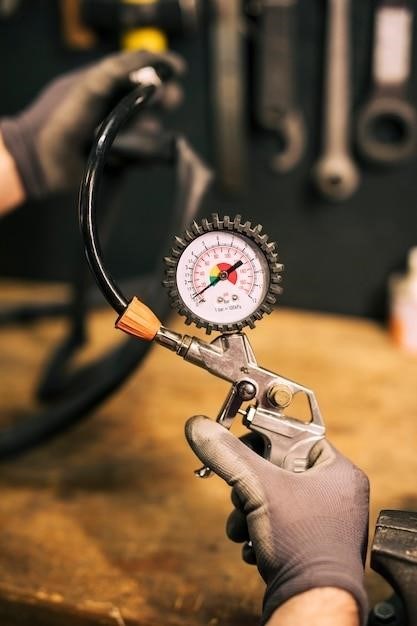hypertherm powermax 45 xp manual
This comprehensive manual provides detailed information on the Hypertherm Powermax 45 XP plasma cutting system. It covers everything from key features and safety precautions to operating instructions‚ maintenance‚ troubleshooting‚ consumables‚ accessories‚ and technical specifications. You’ll also find information on warranty‚ support resources‚ and download links for essential documents.
Introduction
The Hypertherm Powermax 45 XP is a high-performance plasma cutting system designed for a wide range of applications‚ from light industrial to heavy-duty fabrication. It is known for its precision cutting capabilities‚ durability‚ and ease of use. This manual serves as your comprehensive guide to understanding‚ operating‚ and maintaining your Powermax 45 XP system. It is crucial to thoroughly read and understand the information presented in this manual before operating the Powermax 45 XP. This will ensure safe and efficient operation‚ maximize the lifespan of your equipment‚ and help you achieve optimal cutting results.
The manual covers a wide range of topics‚ including⁚
- Key features of the Powermax 45 XP
- Safety precautions to be followed during operation
- Detailed operating instructions for various cutting tasks
- Maintenance procedures to ensure optimal performance
- Troubleshooting tips to address common issues
- Information on consumables and accessories
- Technical specifications for detailed system understanding
- Warranty information and customer support resources
- Download links for additional documentation and resources
By following the instructions outlined in this manual‚ you will be able to maximize the performance and longevity of your Hypertherm Powermax 45 XP system.
Key Features of the Powermax 45 XP
The Hypertherm Powermax 45 XP is a cutting-edge plasma cutting system that boasts a range of features designed to enhance efficiency‚ precision‚ and user experience. These key features make it a popular choice for both industrial and professional applications⁚
- High-Performance Cutting⁚ The Powermax 45 XP delivers exceptional cutting performance‚ achieving precise cuts on a variety of materials‚ including mild steel‚ stainless steel‚ aluminum‚ and more. Its advanced technology ensures clean‚ consistent cuts with minimal dross and edge bevel.
- Compact and Portable Design⁚ Its compact size and lightweight construction make it easy to transport and set up in various work environments‚ making it ideal for both stationary and mobile applications. The portability of the Powermax 45 XP makes it a versatile tool for on-site fabrication‚ repairs‚ and maintenance tasks.
- User-Friendly Interface⁚ The intuitive controls and easy-to-understand display make it simple to operate‚ even for users with limited experience. The Powermax 45 XP features a user-friendly interface that simplifies settings adjustments‚ process selection‚ and overall operation.
- Durable Construction⁚ Built to withstand the rigors of demanding industrial environments‚ the Powermax 45 XP is designed for long-lasting performance. Its robust construction ensures reliability and resilience‚ even in harsh working conditions.
- Advanced Consumables⁚ The Powermax 45 XP utilizes advanced consumables that are engineered for extended lifespan and superior cutting quality. These consumables are designed to provide consistent cutting performance‚ minimize downtime‚ and reduce overall operating costs.
- Safety Features⁚ The Powermax 45 XP is equipped with comprehensive safety features‚ including thermal overload protection‚ arc fault detection‚ and low-voltage shutdown‚ to protect both the operator and the equipment. These safety features contribute to a safer work environment and minimize the risk of accidents.
These key features make the Hypertherm Powermax 45 XP a powerful and reliable tool for various cutting applications;
Safety Precautions
Operating any plasma cutting equipment‚ including the Hypertherm Powermax 45 XP‚ requires a strong emphasis on safety. Failure to adhere to safety precautions can lead to serious injuries or damage to equipment. Before operating the Powermax 45 XP‚ carefully review the safety instructions provided in both the operator’s manual and the Hypertherm Safety and Compliance Manual (80669C); Here are some key safety precautions to always keep in mind⁚
- Eye Protection⁚ Always wear appropriate safety goggles or a face shield to protect your eyes from harmful ultraviolet radiation and flying debris generated during plasma cutting. This is crucial to prevent serious eye injuries.
- Protective Clothing⁚ Wear appropriate clothing‚ including fire-resistant gloves‚ long-sleeved shirts‚ and long pants‚ to protect your skin from burns and sparks. Avoid loose clothing that could get caught in the equipment or become entangled in the cutting process.
- Proper Ventilation⁚ Ensure adequate ventilation in the work area to dissipate fumes and gases generated during plasma cutting. These fumes can be harmful if inhaled. Use a fume extractor or work in a well-ventilated area to minimize exposure.
- Flammable Materials⁚ Keep flammable materials away from the work area. Sparks and hot metal generated during plasma cutting can easily ignite flammable materials‚ creating a fire hazard.
- Electrical Safety⁚ The Powermax 45 XP operates on high voltage and requires careful handling. Always disconnect the power source before performing any maintenance or adjustments. Ensure that the power cord is in good condition and not damaged.
- Grounding⁚ Ensure that the equipment is properly grounded to prevent electrical shock hazards. A proper ground connection will direct electrical current safely to the ground‚ minimizing the risk of electrocution.
- Work Area Safety⁚ Maintain a clean and organized work area to minimize the risk of tripping or falling. Remove clutter and ensure that the work surface is stable and secure.
By following these safety precautions‚ you can minimize the risk of accidents and injuries during plasma cutting operations with the Hypertherm Powermax 45 XP.
Operating Instructions
The Hypertherm Powermax 45 XP plasma cutting system is designed for both handheld and mechanized applications‚ offering versatility and efficiency. To operate the Powermax 45 XP‚ you’ll need to follow a series of steps outlined in the user manual to ensure safe and effective operation. Here’s a general overview of the operating process⁚
- Preparation⁚
- Connect the Powermax 45 XP to a suitable power source‚ ensuring proper grounding; Refer to the manual for specific power requirements.
- Connect the plasma torch to the Powermax 45 XP unit using the appropriate connectors and hoses.
- Adjust the gas pressure according to the type of cutting gas being used. Consult the manual for recommended gas pressures for different materials and thicknesses.
- Select the appropriate cutting current and voltage based on the material you’re cutting. The Powermax 45 XP offers various settings to optimize cutting performance for different materials and thicknesses.
- Ensure that the work area is clear of flammable materials and that adequate ventilation is in place.
- Wear appropriate personal protective equipment (PPE)‚ including safety goggles‚ gloves‚ and fire-resistant clothing.
- Starting the System⁚
- Turn on the Powermax 45 XP unit and allow it to warm up for a few minutes.
- Engage the pilot arc to initiate the plasma arc. Follow the instructions in the manual to initiate the pilot arc safely.
- Cutting⁚
- Position the plasma torch perpendicular to the material surface and maintain a consistent distance. The distance will vary depending on the thickness of the material and the cutting settings.
- Initiate the cut by pressing the trigger on the plasma torch. Move the torch slowly and steadily along the cutting path‚ ensuring that the arc remains stable.
- After completing the cut‚ release the trigger and allow the plasma arc to extinguish before moving the torch away from the work area.
- Shutting Down⁚
- Turn off the Powermax 45 XP unit and allow it to cool down before disconnecting the torch and power cord.
- Clean the torch and consumables to remove any debris or residue. Regular cleaning helps to maintain optimal cutting performance and extends the life of consumables.
This is a general overview of the operating procedures. Refer to the detailed instructions provided in the Powermax 45 XP manual for specific information on operating the system and troubleshooting any issues that may arise. Safety should always be paramount when operating any plasma cutting equipment‚ and it is essential to follow all safety guidelines and procedures.
Maintenance and Troubleshooting
Regular maintenance is crucial for ensuring optimal performance and longevity of your Hypertherm Powermax 45 XP plasma cutting system. The manual provides detailed instructions for maintenance procedures‚ which should be performed at regular intervals to prevent issues and extend the lifespan of the system.

Here are some key maintenance tasks⁚
- Clean the torch and consumables⁚ Regularly clean the torch nozzle‚ electrode‚ and other consumables to remove debris and ensure proper cutting performance. Use the appropriate cleaning tools and procedures outlined in the manual.
- Check and adjust gas pressure⁚ Ensure that the gas pressure is set correctly according to the type of cutting gas being used and the material thickness. Consult the manual for recommended gas pressures.
- Inspect the power cord and connections⁚ Regularly inspect the power cord and connections for any signs of damage or wear. Replace any damaged components immediately to prevent electrical hazards.
- Check the air filter⁚ The air filter should be checked and cleaned regularly to prevent dust and debris from entering the system. A clogged air filter can impact cutting performance and system lifespan.
- Inspect the cooling system⁚ The cooling system is essential for preventing overheating and ensuring reliable operation. Check the cooling fan and other components for proper functionality.
In addition to regular maintenance‚ it’s important to troubleshoot any problems that may arise. The Powermax 45 XP manual provides detailed troubleshooting information for various issues‚ including⁚
- Cutting problems⁚ Issues like inconsistent cutting quality‚ excessive kerf width‚ or difficulty starting the cut can be addressed by following the troubleshooting steps in the manual.
- Torch problems⁚ Problems with the torch‚ such as arcing issues‚ overheating‚ or damage to the consumables‚ can be diagnosed and resolved using the troubleshooting guides in the manual.
- Power problems⁚ If the Powermax 45 XP is experiencing power issues‚ such as a blown fuse or a faulty power connection‚ the manual provides steps for troubleshooting and resolving these problems.
Remember to always follow the safety guidelines and procedures provided in the manual when performing any maintenance or troubleshooting tasks. If you encounter any issues that you are unable to resolve yourself‚ contact Hypertherm customer support for assistance.
Consumables and Accessories
The Hypertherm Powermax 45 XP plasma cutting system utilizes a range of consumables and accessories to ensure optimal performance and cutting quality. The manual provides detailed information about these components‚ including their functions‚ specifications‚ and replacement procedures.
Key consumables include⁚
- Torch nozzles⁚ The torch nozzle is a critical component that directs the plasma arc and shapes the cutting path. The manual details the different nozzle sizes and materials available for various cutting applications and material thicknesses.
- Electrodes⁚ The electrode generates the plasma arc and is a consumable item. The manual outlines the various electrode types and their suitability for different cutting tasks.
- Shields⁚ The shield protects the electrode and nozzle from heat and debris during cutting. The manual explains the different shield designs and their applications.
- Cutting gas⁚ The Powermax 45 XP utilizes various cutting gases‚ such as air‚ oxygen‚ nitrogen‚ and argon. The manual provides guidance on selecting the appropriate gas based on the cutting application and material type.
In addition to consumables‚ the Powermax 45 XP can be enhanced with various accessories‚ such as⁚
- Cutting torches⁚ The manual details the different torch models available for the Powermax 45 XP‚ including hand torches‚ mechanized torches‚ and torches designed for specific applications.
- Cutting tables⁚ Cutting tables provide a stable and secure platform for cutting materials. The manual outlines the different table sizes and features available.
- CNC controllers⁚ For automated cutting operations‚ the Powermax 45 XP can be integrated with CNC controllers. The manual provides guidance on connecting and configuring the system with CNC equipment.
- Dust collection systems⁚ Dust collection systems are essential for maintaining a clean working environment and protecting the operator from harmful fumes and dust. The manual describes the different dust collection options available for the Powermax 45 XP.
The Hypertherm Powermax 45 XP manual provides comprehensive information on the selection‚ use‚ and maintenance of consumables and accessories. By using the correct consumables and accessories‚ you can optimize cutting performance‚ ensure safety‚ and extend the lifespan of your plasma cutting system.
Technical Specifications
The Hypertherm Powermax 45 XP manual details the technical specifications of the plasma cutting system‚ providing crucial information for understanding its capabilities and limitations. These specifications cover key aspects such as power output‚ cutting capacity‚ operating parameters‚ and physical dimensions.
The manual outlines the following technical specifications⁚
- Power output⁚ The Powermax 45 XP delivers a maximum power output of 45 amps‚ enabling it to cut a wide range of materials and thicknesses. The manual specifies the power output range for different cutting applications and material types.
- Cutting capacity⁚ The system is designed to cut a variety of materials‚ including steel‚ aluminum‚ stainless steel‚ and copper. The manual provides detailed information on the maximum cutting thickness for different materials‚ using various cutting gases.
- Operating parameters⁚ The manual outlines the recommended operating parameters for the Powermax 45 XP‚ including cutting current‚ gas pressure‚ and cutting speed. It also details how to adjust these parameters to optimize cutting performance for different materials and thicknesses.
- Duty cycle⁚ The duty cycle describes the percentage of time the system can operate at its maximum power output before needing to cool down. The manual provides information on the duty cycle for the Powermax 45 XP‚ allowing users to plan cutting operations and avoid overheating the system.
- Physical dimensions⁚ The manual provides the dimensions and weight of the Powermax 45 XP unit‚ including the size of the power source and the cutting torch. This information is essential for planning storage‚ transportation‚ and workspace requirements.
- Electrical requirements⁚ The manual specifies the electrical requirements for the Powermax 45 XP‚ including voltage‚ amperage‚ and frequency. This ensures proper connection to the power supply and safe operation of the system.
Understanding the technical specifications of the Powermax 45 XP is crucial for selecting the right consumables‚ setting the appropriate operating parameters‚ and ensuring safe and efficient operation of the plasma cutting system.


